Le Zhang
Emerging Semantic Segmentation from Positive and Negative Coarse Label Learning
Aug 25, 2025Abstract:Large annotated datasets are vital for training segmentation models, but pixel-level labeling is time-consuming, error-prone, and often requires scarce expert annotators, especially in medical imaging. In contrast, coarse annotations are quicker, cheaper, and easier to produce, even by non-experts. In this paper, we propose to use coarse drawings from both positive (target) and negative (background) classes in the image, even with noisy pixels, to train a convolutional neural network (CNN) for semantic segmentation. We present a method for learning the true segmentation label distributions from purely noisy coarse annotations using two coupled CNNs. The separation of the two CNNs is achieved by high fidelity with the characters of the noisy training annotations. We propose to add a complementary label learning that encourages estimating negative label distribution. To illustrate the properties of our method, we first use a toy segmentation dataset based on MNIST. We then present the quantitative results of experiments using publicly available datasets: Cityscapes dataset for multi-class segmentation, and retinal images for medical applications. In all experiments, our method outperforms state-of-the-art methods, particularly in the cases where the ratio of coarse annotations is small compared to the given dense annotations.
SAGCNet: Spatial-Aware Graph Completion Network for Missing Slice Imputation in Population CMR Imaging
Aug 09, 2025Abstract:Magnetic resonance imaging (MRI) provides detailed soft-tissue characteristics that assist in disease diagnosis and screening. However, the accuracy of clinical practice is often hindered by missing or unusable slices due to various factors. Volumetric MRI synthesis methods have been developed to address this issue by imputing missing slices from available ones. The inherent 3D nature of volumetric MRI data, such as cardiac magnetic resonance (CMR), poses significant challenges for missing slice imputation approaches, including (1) the difficulty of modeling local inter-slice correlations and dependencies of volumetric slices, and (2) the limited exploration of crucial 3D spatial information and global context. In this study, to mitigate these issues, we present Spatial-Aware Graph Completion Network (SAGCNet) to overcome the dependency on complete volumetric data, featuring two main innovations: (1) a volumetric slice graph completion module that incorporates the inter-slice relationships into a graph structure, and (2) a volumetric spatial adapter component that enables our model to effectively capture and utilize various forms of 3D spatial context. Extensive experiments on cardiac MRI datasets demonstrate that SAGCNet is capable of synthesizing absent CMR slices, outperforming competitive state-of-the-art MRI synthesis methods both quantitatively and qualitatively. Notably, our model maintains superior performance even with limited slice data.
Coarse-to-Fine Joint Registration of MR and Ultrasound Images via Imaging Style Transfer
Aug 07, 2025Abstract:We developed a pipeline for registering pre-surgery Magnetic Resonance (MR) images and post-resection Ultrasound (US) images. Our approach leverages unpaired style transfer using 3D CycleGAN to generate synthetic T1 images, thereby enhancing registration performance. Additionally, our registration process employs both affine and local deformable transformations for a coarse-to-fine registration. The results demonstrate that our approach improves the consistency between MR and US image pairs in most cases.
MobileIE: An Extremely Lightweight and Effective ConvNet for Real-Time Image Enhancement on Mobile Devices
Jul 02, 2025Abstract:Recent advancements in deep neural networks have driven significant progress in image enhancement (IE). However, deploying deep learning models on resource-constrained platforms, such as mobile devices, remains challenging due to high computation and memory demands. To address these challenges and facilitate real-time IE on mobile, we introduce an extremely lightweight Convolutional Neural Network (CNN) framework with around 4K parameters. Our approach integrates reparameterization with an Incremental Weight Optimization strategy to ensure efficiency. Additionally, we enhance performance with a Feature Self-Transform module and a Hierarchical Dual-Path Attention mechanism, optimized with a Local Variance-Weighted loss. With this efficient framework, we are the first to achieve real-time IE inference at up to 1,100 frames per second (FPS) while delivering competitive image quality, achieving the best trade-off between speed and performance across multiple IE tasks. The code will be available at https://github.com/AVC2-UESTC/MobileIE.git.
REARANK: Reasoning Re-ranking Agent via Reinforcement Learning
May 26, 2025Abstract:We present REARANK, a large language model (LLM)-based listwise reasoning reranking agent. REARANK explicitly reasons before reranking, significantly improving both performance and interpretability. Leveraging reinforcement learning and data augmentation, REARANK achieves substantial improvements over baseline models across popular information retrieval benchmarks, notably requiring only 179 annotated samples. Built on top of Qwen2.5-7B, our REARANK-7B demonstrates performance comparable to GPT-4 on both in-domain and out-of-domain benchmarks and even surpasses GPT-4 on reasoning-intensive BRIGHT benchmarks. These results underscore the effectiveness of our approach and highlight how reinforcement learning can enhance LLM reasoning capabilities in reranking.
Semantically-Aware Game Image Quality Assessment
May 16, 2025Abstract:Assessing the visual quality of video game graphics presents unique challenges due to the absence of reference images and the distinct types of distortions, such as aliasing, texture blur, and geometry level of detail (LOD) issues, which differ from those in natural images or user-generated content. Existing no-reference image and video quality assessment (NR-IQA/VQA) methods fail to generalize to gaming environments as they are primarily designed for distortions like compression artifacts. This study introduces a semantically-aware NR-IQA model tailored to gaming. The model employs a knowledge-distilled Game distortion feature extractor (GDFE) to detect and quantify game-specific distortions, while integrating semantic gating via CLIP embeddings to dynamically weight feature importance based on scene content. Training on gameplay data recorded across graphical quality presets enables the model to produce quality scores that align with human perception. Our results demonstrate that the GDFE, trained through knowledge distillation from binary classifiers, generalizes effectively to intermediate distortion levels unseen during training. Semantic gating further improves contextual relevance and reduces prediction variance. In the absence of in-domain NR-IQA baselines, our model outperforms out-of-domain methods and exhibits robust, monotonic quality trends across unseen games in the same genre. This work establishes a foundation for automated graphical quality assessment in gaming, advancing NR-IQA methods in this domain.
Gameplay Highlights Generation
May 12, 2025Abstract:In this work, we enable gamers to share their gaming experience on social media by automatically generating eye-catching highlight reels from their gameplay session Our automation will save time for gamers while increasing audience engagement. We approach the highlight generation problem by first identifying intervals in the video where interesting events occur and then concatenate them. We developed an in-house gameplay event detection dataset containing interesting events annotated by humans using VIA video annotator. Traditional techniques for highlight detection such as game engine integration requires expensive collaboration with game developers. OCR techniques which detect patches of specific images or texts require expensive per game engineering and may not generalize across game UI and different language. We finetuned a multimodal general purpose video understanding model such as X-CLIP using our dataset which generalizes across multiple games in a genre without per game engineering. Prompt engineering was performed to improve the classification performance of this multimodal model. Our evaluation showed that such a finetuned model can detect interesting events in first person shooting games from unseen gameplay footage with more than 90% accuracy. Moreover, our model performed significantly better on low resource games (small dataset) when trained along with high resource games, showing signs of transfer learning. To make the model production ready, we used ONNX libraries to enable cross platform inference. These libraries also provide post training quantization tools to reduce model size and inference time for deployment. ONNX runtime libraries with DirectML backend were used to perform efficient inference on Windows OS. We show that natural language supervision in the X-CLIP model leads to data efficient and highly performant video recognition models.
Prompt to Restore, Restore to Prompt: Cyclic Prompting for Universal Adverse Weather Removal
Mar 12, 2025
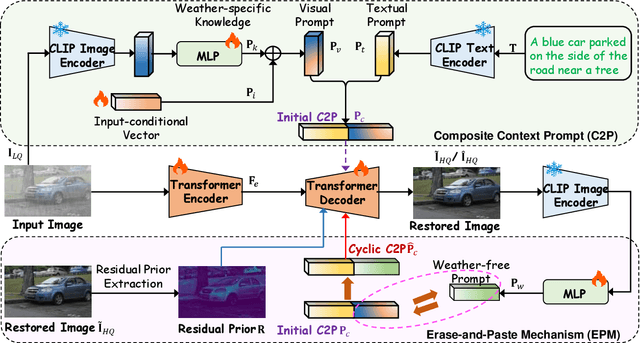
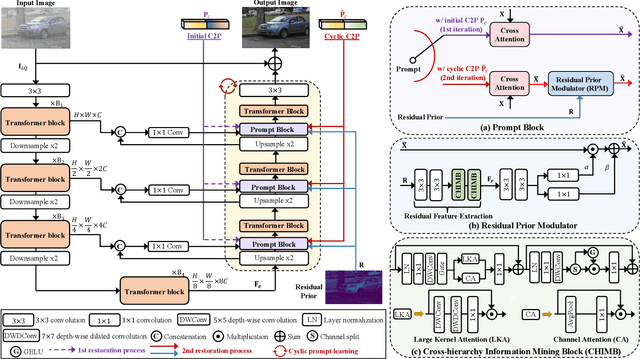
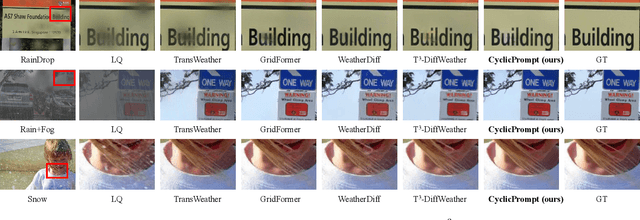
Abstract:Universal adverse weather removal (UAWR) seeks to address various weather degradations within a unified framework. Recent methods are inspired by prompt learning using pre-trained vision-language models (e.g., CLIP), leveraging degradation-aware prompts to facilitate weather-free image restoration, yielding significant improvements. In this work, we propose CyclicPrompt, an innovative cyclic prompt approach designed to enhance the effectiveness, adaptability, and generalizability of UAWR. CyclicPrompt Comprises two key components: 1) a composite context prompt that integrates weather-related information and context-aware representations into the network to guide restoration. This prompt differs from previous methods by marrying learnable input-conditional vectors with weather-specific knowledge, thereby improving adaptability across various degradations. 2) The erase-and-paste mechanism, after the initial guided restoration, substitutes weather-specific knowledge with constrained restoration priors, inducing high-quality weather-free concepts into the composite prompt to further fine-tune the restoration process. Therefore, we can form a cyclic "Prompt-Restore-Prompt" pipeline that adeptly harnesses weather-specific knowledge, textual contexts, and reliable textures. Extensive experiments on synthetic and real-world datasets validate the superior performance of CyclicPrompt. The code is available at: https://github.com/RongxinL/CyclicPrompt.
DeepNuParc: A Novel Deep Clustering Framework for Fine-scale Parcellation of Brain Nuclei Using Diffusion MRI Tractography
Mar 10, 2025



Abstract:Brain nuclei are clusters of anatomically distinct neurons that serve as important hubs for processing and relaying information in various neural circuits. Fine-scale parcellation of the brain nuclei is vital for a comprehensive understanding of its anatomico-functional correlations. Diffusion MRI tractography is an advanced imaging technique that can estimate the brain's white matter structural connectivity to potentially reveal the topography of the nuclei of interest for studying its subdivisions. In this work, we present a deep clustering pipeline, namely DeepNuParc, to perform automated, fine-scale parcellation of brain nuclei using diffusion MRI tractography. First, we incorporate a newly proposed deep learning approach to enable accurate segmentation of the nuclei of interest directly on the dMRI data. Next, we design a novel streamline clustering-based structural connectivity feature for a robust representation of voxels within the nuclei. Finally, we improve the popular joint dimensionality reduction and k-means clustering approach to enable nuclei parcellation at a finer scale. We demonstrate DeepNuParc on two important brain structures, i.e. the amygdala and the thalamus, that are known to have multiple anatomically and functionally distinct nuclei subdivisions. Experimental results show that DeepNuParc enables consistent parcellation of the nuclei into multiple parcels across multiple subjects and achieves good correspondence with the widely used coarse-scale atlases. Our codes are available at https://github.com/HarlandZZC/deep_nuclei_parcellation.
TimeFound: A Foundation Model for Time Series Forecasting
Mar 06, 2025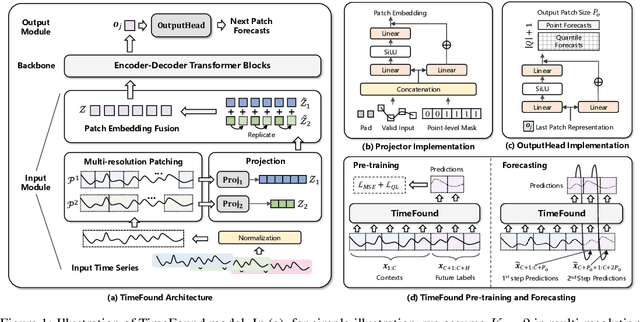
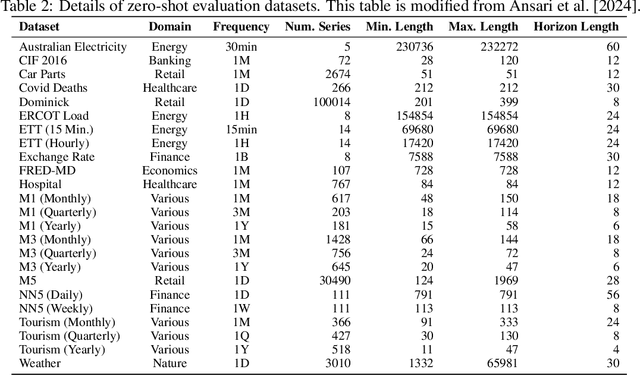
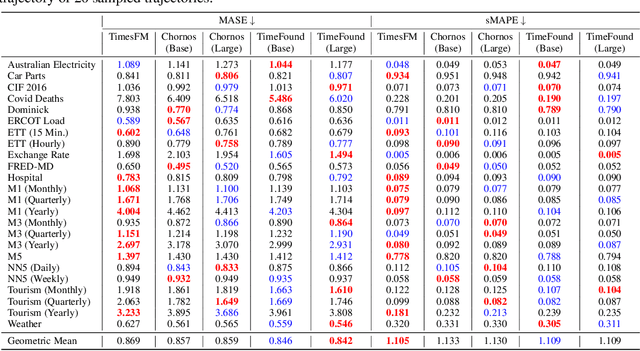
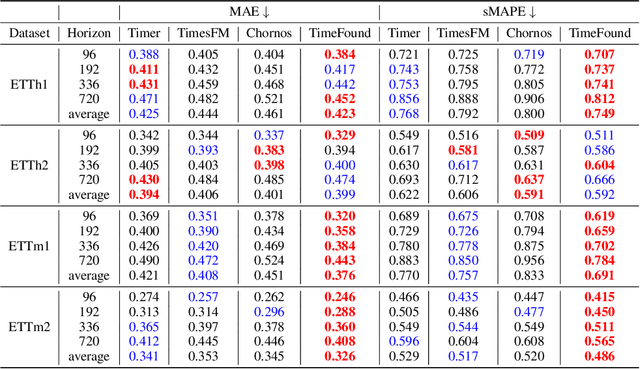
Abstract:We present TimeFound, an encoder-decoder transformer-based time series foundation model for out-of-the-box zero-shot forecasting. To handle time series data from various domains, TimeFound employs a multi-resolution patching strategy to capture complex temporal patterns at multiple scales. We pre-train our model with two sizes (200M and 710M parameters) on a large time-series corpus comprising both real-world and synthetic datasets. Over a collection of unseen datasets across diverse domains and forecasting horizons, our empirical evaluations suggest that TimeFound can achieve superior or competitive zero-shot forecasting performance, compared to state-of-the-art time series foundation models.
 Add to Chrome
Add to Chrome Add to Firefox
Add to Firefox Add to Edge
Add to Edge